中考英语专题复习课件:简单句,并列句,复合句课件(41张PPT)
文档属性
| 名称 | 中考英语专题复习课件:简单句,并列句,复合句课件(41张PPT) | 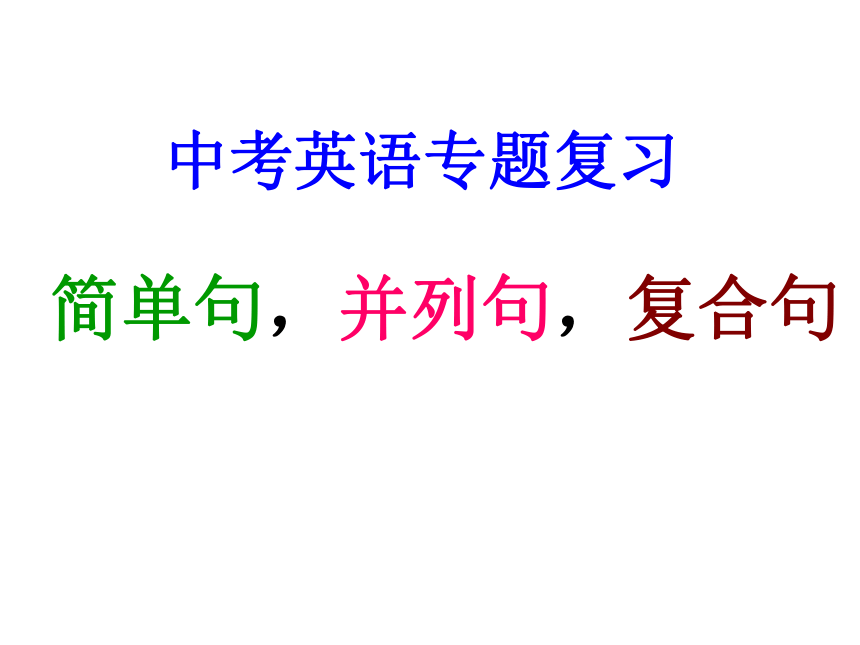 | |
| 格式 | zip | ||
| 文件大小 | 843.8KB | ||
| 资源类型 | 教案 | ||
| 版本资源 | 人教新目标(Go for it)版 | ||
| 科目 | 英语 | ||
| 更新时间 | 2018-12-05 22:10:23 | ||
图片预览

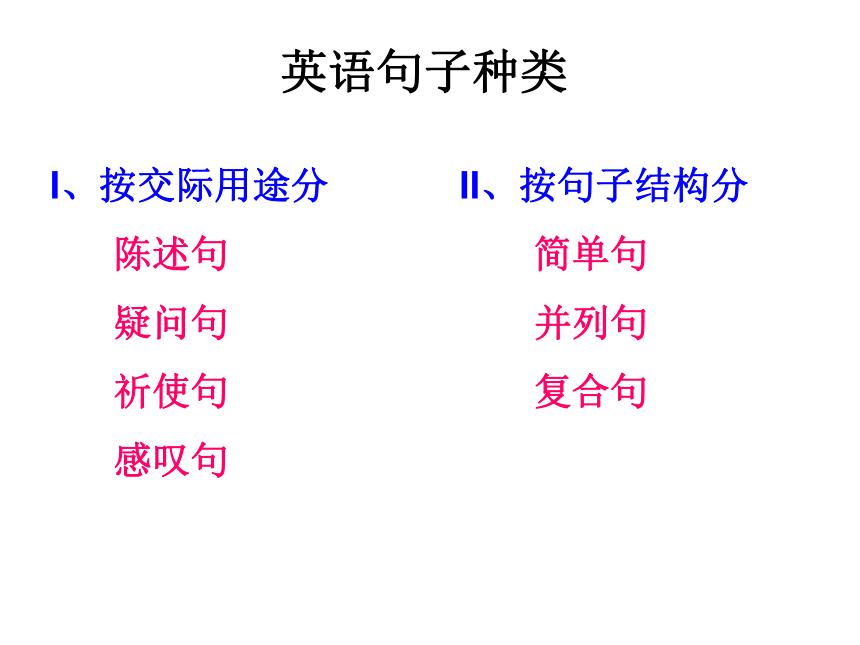
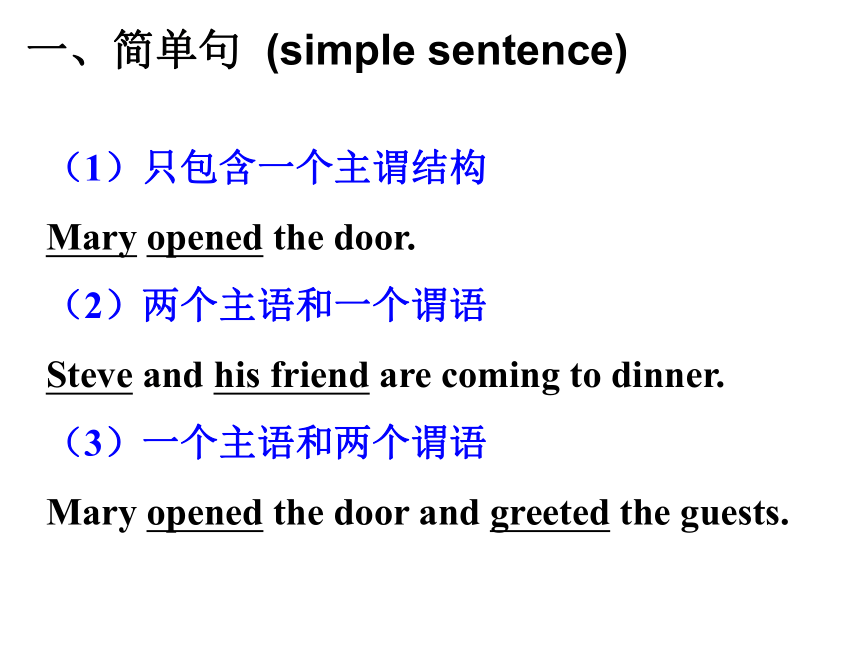
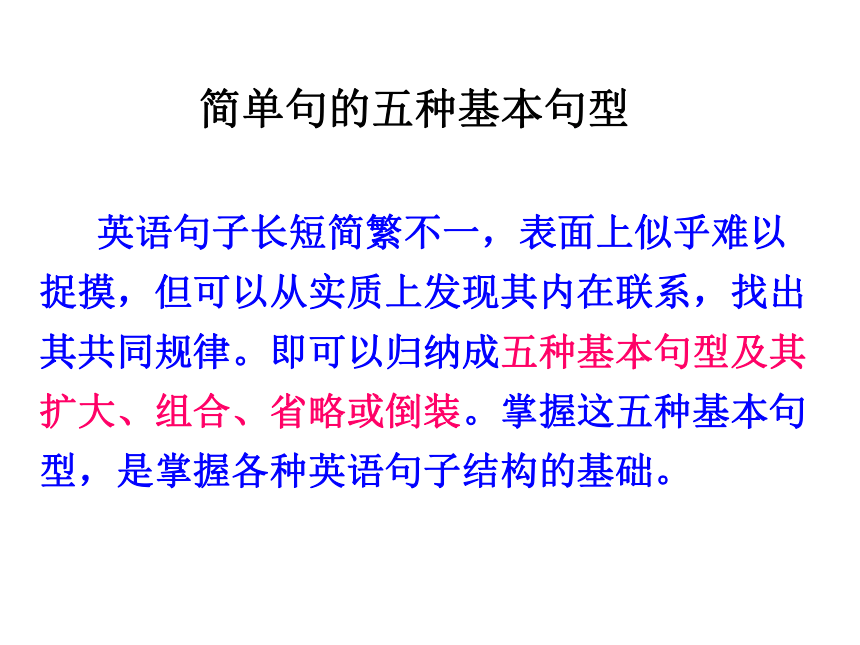
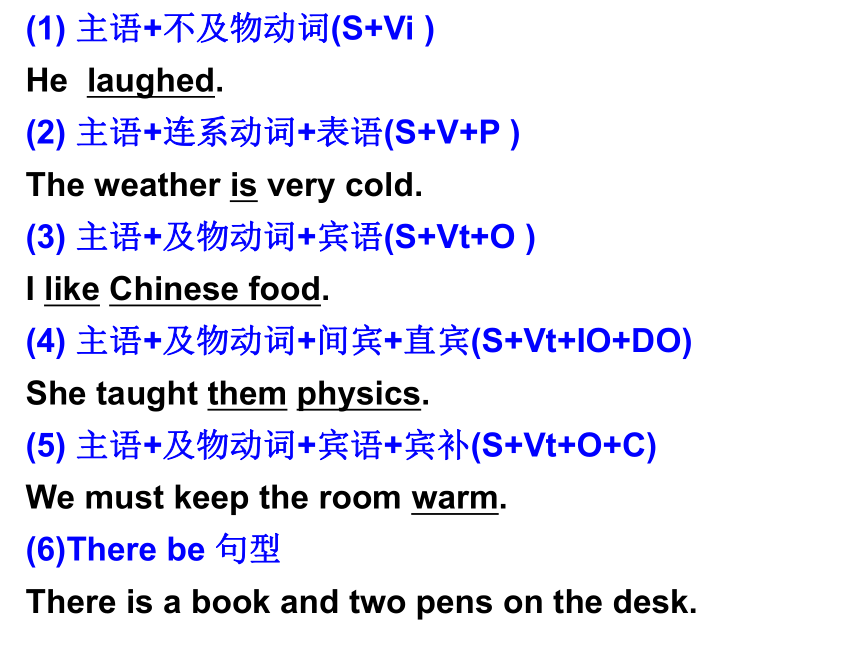
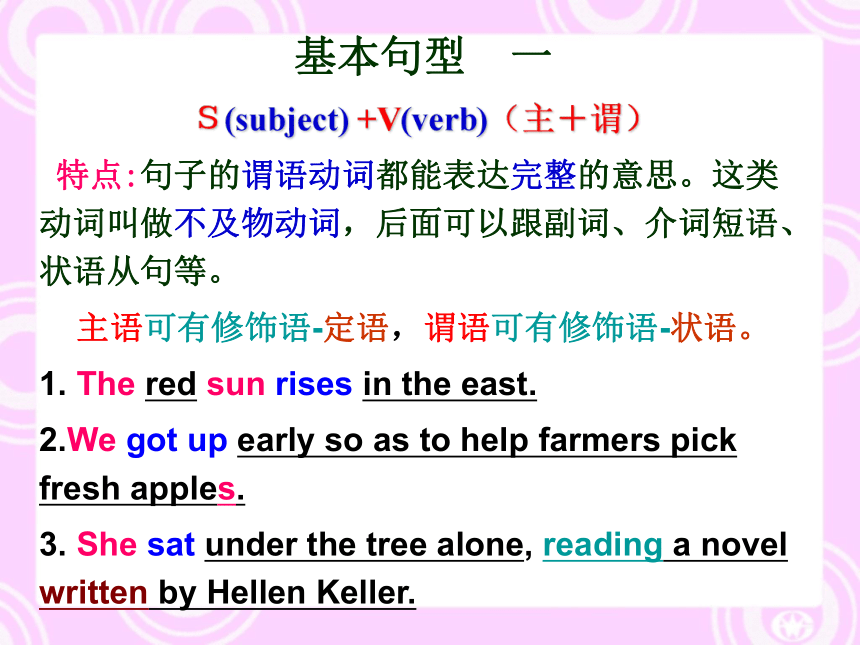

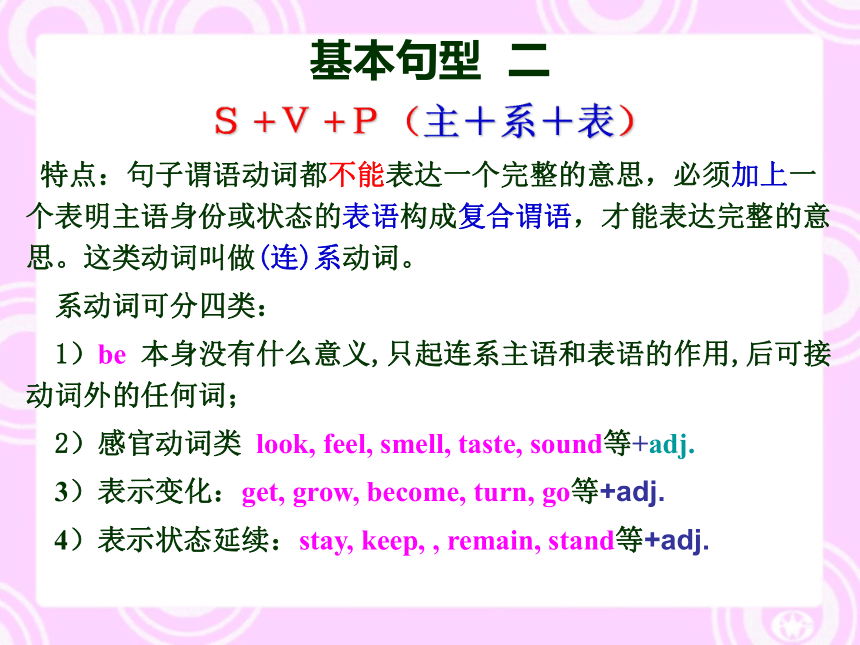
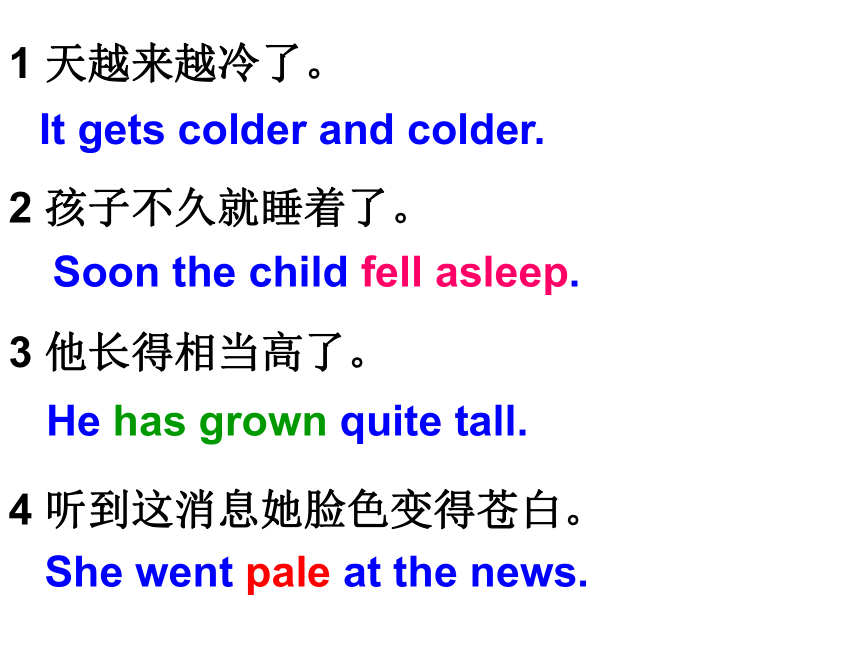
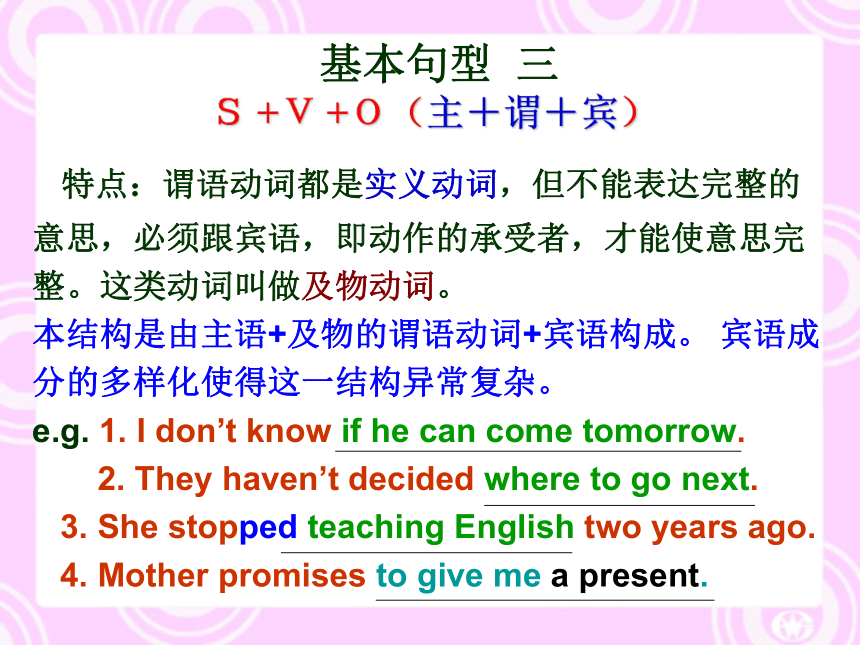

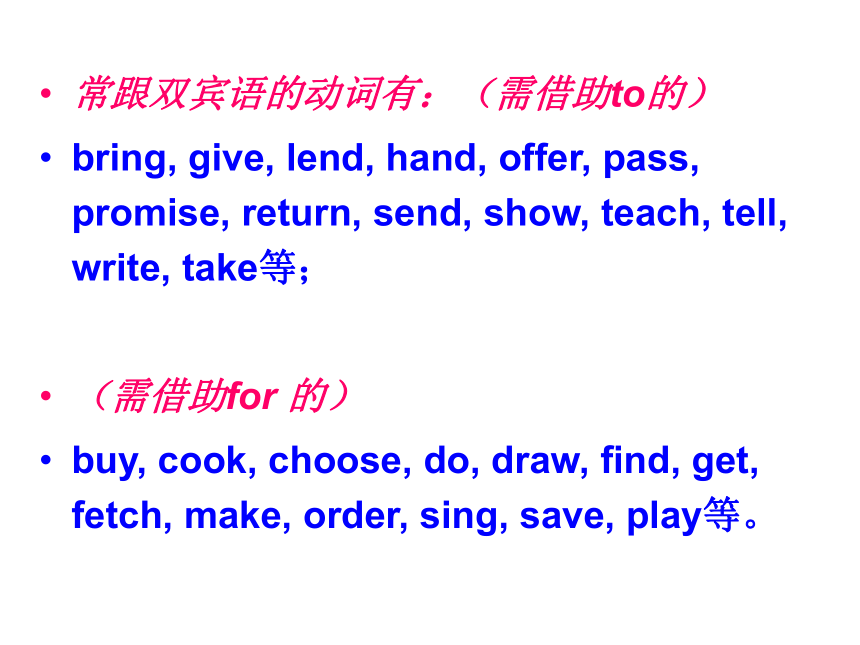
文档简介
课件41张PPT。中考英语专题复习简单句,并列句,复合句英语句子种类 I、按交际用途分
陈述句
疑问句
祈使句
感叹句
II、按句子结构分
简单句
并列句
复合句
一、简单句 (simple sentence) (1)只包含一个主谓结构
Mary opened the door.
(2)两个主语和一个谓语
Steve and his friend are coming to dinner.
(3)一个主语和两个谓语
Mary opened the door and greeted the guests. 简单句的五种基本句型 英语句子长短简繁不一,表面上似乎难以捉摸,但可以从实质上发现其内在联系,找出其共同规律。即可以归纳成五种基本句型及其扩大、组合、省略或倒装。掌握这五种基本句型,是掌握各种英语句子结构的基础。(1) 主语+不及物动词(S+Vi )
He laughed.
(2) 主语+连系动词+表语(S+V+P )
The weather is very cold.
(3) 主语+及物动词+宾语(S+Vt+O )
I like Chinese food.
(4) 主语+及物动词+间宾+直宾(S+Vt+IO+DO)
She taught them physics.
(5) 主语+及物动词+宾语+宾补(S+Vt+O+C)
We must keep the room warm.
(6)There be 句型
There is a book and two pens on the desk.
基本句型 一
S(subject) +V(verb)(主+谓)
特点:句子的谓语动词都能表达完整的意思。这类动词叫做不及物动词,后面可以跟副词、介词短语、状语从句等。
主语可有修饰语-定语,谓语可有修饰语-状语。
1. The red sun rises in the east.
2.We got up early so as to help farmers pick fresh apples.
3. She sat under the tree alone, reading a novel written by Hellen Keller.
常用的不及物动词(vi.)
listen, talk, work, run, swim, jump, rise, laugh, come, go, arrive, happen, look等。
属性动词:
wash, sell, wear, read, write等与well, easily, smoothly等副词连用基本句型 二
S +V +P(主+系+表)
特点:句子谓语动词都不能表达一个完整的意思,必须加上一个表明主语身份或状态的表语构成复合谓语,才能表达完整的意思。这类动词叫做(连)系动词。
系动词可分四类:
1)be 本身没有什么意义,只起连系主语和表语的作用,后可接动词外的任何词;
2)感官动词类 look, feel, smell, taste, sound等+adj.
3)表示变化:get, grow, become, turn, go等+adj.
4)表示状态延续:stay, keep, , remain, stand等+adj. 1 天越来越冷了。
2 孩子不久就睡着了。
3 他长得相当高了。
4 听到这消息她脸色变得苍白。 It gets colder and colder. Soon the child fell asleep.She went pale at the news. He has grown quite tall. 基本句型 三
S +V +O(主+谓+宾)
特点:谓语动词都是实义动词,但不能表达完整的意思,必须跟宾语,即动作的承受者,才能使意思完整。这类动词叫做及物动词。
本结构是由主语+及物的谓语动词+宾语构成。 宾语成分的多样化使得这一结构异常复杂。
e.g. 1. I don’t know if he can come tomorrow.
2. They haven’t decided where to go next.
3. She stopped teaching English two years ago.
4. Mother promises to give me a present.
基本句型 四
S +V +InO +DO(主+谓+间宾+直宾)
特点:谓语动词必须跟有两个宾语才能表达完整的意思。这两个宾语一个是动作的直接承受者,另一个是动作的间接承受者。通常可改为
S + V + DO + to/for + InO
e.g. She gave me an apple.
=She gave an apple to me.
She made a beautiful dress for me.
用to侧重指动作的方向,表示朝着,向着,对着某人。
用for 侧重指动作的受益者,表示为了某人,替某人。常跟双宾语的动词有:(需借助to的)
bring, give, lend, hand, offer, pass, promise, return, send, show, teach, tell, write, take等;
(需借助for 的)
buy, cook, choose, do, draw, find, get, fetch, make, order, sing, save, play等。
基本句型 五
S +V +O +OC(主+谓+宾+宾补)
特点:动词虽然是及物动词,但是只跟一个宾语还不能表达完整的意思,必须加上一个补充成分来补足宾语,才能使意思完整.宾语与宾语补足语之间有逻辑上的主谓关系或主表关系,可以用做宾补的有:名词,形容词,副词,介词短语,动词不定式,分词等。
判断原则:能表达成—宾语 是…/做…
e.g. We made him manager.
The sun keeps us warm.
I heard him singing.
You must get your hair cut.
I found it very pleasant to be with your family. 注意: 同一个动词使用的句型也不尽一样,因此在学习动词时,应掌握动词的类型。以 get 为例:
He's getting angry. (S V P)
You'll get a surprise. (S V O)
He got his shoes and socks wet. (S V O C)
在句子中词类也影响句子的句型和意思:
I found the book easily.
我很容易地找到了这本书。( S V O )
I found the book easy.
我觉得这本书很容易。 (S V O C)
英语基本句型6 There be 句型
说明: 此句型是由“there+be+主语+状语”构成,用以表达存在关系可以称“……有……”。 它其实是倒装的一种情况,主语位于谓语动词 be 之后,there 仅为引导词,并无实际语意。注意观察下面的句子:
There is a pen, two rulers in the box.
There is a purse lying on the ground.
There are five minutes left now.
There is a lot of work to do.
There is a radio on the table, isn't there?
There may be a rain this afternoon.
There used to be a cinema here.
此句型有时不用be动词,而用 live, stand, come, go, lie, arrive等。如:
There stands a hill in the middle of the park.
Once upon a time there lived an old king in the town.
Be 与其后的主语在人称和数量上一致,有时态和情态变化。如:
现在有 there is/are …
过去有 there was/were…
将来有 there will be…;there is /are going to be...
现在已经有 there has/have been…
可能有 there might be...
肯定有 there must be …
过去曾经有 there used to be …
似乎有 there seems/seem/seemed to be …
碰巧有 there happen/happens/happened to be …二、并列句(compound sentence):
把两个或几个简单句用并列连词连接起来,则成为一个并列句。
I got up late.
I didn’t catch the bus.
I got up late, so I didn’t catch the bus.
I bought my sister a present.
She didn’t like it.
I bought my sister a present, but she didn’t like it.
并列句并列句常用并列连词 coordinating conjunctions
平行并列连词:
转折并列连词:
因果并列连词:
选择并列连词:and, both…and, not only…
but also, neither…norbut, however, while, yet,whenfor, so, therefore
adv. 因此;所以 or, otherwise , either…or
adv. 否则;另外;在其他方面
1.August is the time of the year for harvesting , ________every day I work from dawn until dark.黎明
2.He is a basketball fan,____ his wife is a volleyball fan. n. 刺,叮,螫;☉刺伤,3.Honey is sweet,_____ the bee stings. 4.Don’t be late, ______there is a meeting.
5.Hurry up, ____you’ll be late.
6.He works hard ______his brother is a lazy bone.
7.He was enjoying his KFC _____ a friend came.练习一 :用连词填空soandbutfororwhilewhen三、复合句:主句+从句
主句是一个完整的句子(independent sentence),它可以独立存在。
从句是一个不完整的句子,它必须和一个主句连用,不能独立存在.By the time he arrived,
1
we had already left.
2请指出该复合句的主句和从句部分。从句主句在复合句中,主要包含以下类型从句:
1.状语从句
2.定语从句
3.名词性从句:
宾语从句
主语从句
表语从句
同位语从句
指出下列各从句的类型:I hope that everything is all right.
She was reading the newspaper when I came in.
She is the girl who sings best of all.
宾语从句状语从句定语从句He has found out .She was late.(why)请用括号中所给的词把每组句子连接为一个复合句。I still remember the day .I first came to Beijing on that day.(when)I still remember the day when I first
came to Beijing.He has found out why she was late.9种状语从句 即用作状语的分句
1、时间(after, before, as, when, while, since, till, until, when , as soon as; );
2、地点(where, wherever) ;
3、方式(as, as if, ) ;
4、程度/比较(as…as , more …than, ) ;5、原因(because, since, as ,) ;
6、结果(,so that ,so…that ,such…that) ;
7、目的(so that ,in order that ) ;
8、条件(if, unless) ;
9、让步(though ,although, even if/though , whenever ,wherever, whoever , whichever, however , no matter how, whether) 。并列复合句
即并列连词连接了带从句的并列句。English is widely used in the world, but China has the largest number of people who speak Chinese.请用所学知识改正下列病句
My roommate was sleeping,
we didn’t want to wake her up.
I went to bed. Because I was
tired.
My roommate was sleeping .
We didn’t want to wake her up.
My roommate was sleeping, so
we didn’t want to wake her up.
I went to bed because I was
tired.练习二、简单句、并列句和复合句一、判断下列句子是简单句、并列句还是复合句:
1. We often study Chinese history on Friday afternoon.
2. The boy who offered me his seat is called Tom.
3. There is a chair in this room, isn’t there?
4. My brother and I go to school at half past seven in the morning and come back home at seven in the evening.简单句 复合句 简单句 简单句 5. He is in Class One and I am in Class Two.
6. He was fond of drawing when he was yet a child.
7. Neither has he changed his mind, nor will he do so.
8. What he said at the meeting is very important, isn’t it?
9. The farmer is showing the boy how to plant a tree.
10. Both Tom and Jack enjoy country music.并列句 复合句 并列句 复合句 简单句 简单句 三、选择填空:1. Give me one more minute ____ I’ll be able to finish it.
A. and B. or C. if D. so
2. It’s the third time that John has been late, ____?
A. hasn’t he B. isn’t he
C. isn’t it D. hasn’t it
3. ____ joyful he was to meet his brother again!
A. How B. What C. What a D. What an4. Let us pass, ____?
A. shan’t we B. shall we C. won’t we D. will you
5. I suppose he’s serious, ____ ?
A. do I B. don’t I C. is he D. isn’t he
6. You had better not smoke here, ____?
A. will you B. had you
C. shall you D. have you
7. Train as hard as you can ____ you’ll win the swimming competition.
A. then B. but C. and D. or8. I’m sorry to have to say this, ____ you forgot to turn off the lights when you left the room last night.
A. and B. but C. so D. because
9. John has not yet passed the driving test, and ____.
A. Henry hasn’t too B. Henry also has not either
C. neither Henry has D. neither has Henry
10. There are many sports lovers in his office. Some love climbing, ____ others enjoy swimming.
A. or B. for
C. while D. so
11. ---- Do you feel like going out ____ would you rather have dinner at home?
---- I’d like to go out.
A. or B. and C. but D. so12. ---- “____ is the temperature today?”
----“It’s 38 degrees.”
A. Which B. How C. How hot D. How high
13. ---- Your uncle isn’t an engineer, is he? ---- ____.
A. Yes, he isn’t B. No, he isn’t C. No, he is D. He is
14. ____ friendly ____ to everyone!
A. How, is she B. What, is she C. How, she is D. What, she is
15. Mary went to bed early, ____ she felt very tired.
A. or B. so C. for D. yet16. Mother ____ a dress when she cut her finger.
A. was making B. makes C. is making D. made
17. He lay in bed ____ read something borrowed from library.
A. but B. and C. or D. yet
18. ---- I’d really like some lunch but I have so much work to do.
---- ____ what you want and I can get it for you.
A. Tell me B. If you would say to me
C. You will tell me D. If you tell me
19. As he is strong, ____ can lift one hundred pounds.
A. yet he B. but he C. and D. he20. ---- I thought you had an umbrella.
---- I had, ____ I’ve lost it.
A. since B. but C. because D. so
21. ____ down the radio ---- the baby’s asleep in the next room.
A. Turning B. To turn C. Turned D. Turn
22. ---- I don’t like chicken ____ fish.
---- I don’t like chicken ____ I like fish very much.
A. and, and B. and, but
C. or, and D. or, but
23. ---- Would you like to come to dinner tonight? ---- I’d like to, ____ I’m too busy.
A. and B. so C. as D. but 24. Would you like a cup of coffee ____ shall we get down to business right away?
A. and B. then C. or D. otherwise
25. She set out soon after dark ____ home an hour later.
A. arriving B. to arrive C. having arrived D. and arrived
26. “Can’t you read?” Mary said ____ to the notice.
A. angrily pointing B. and point angrily C. angrily pointed D. and angrily pointed
27. She thought I was talking about her daughter, ____, in fact, I was talking about my daughter.
A. whom B. where C. which D. while28. ____ it with me and I’ll see what I can do.
A. When left B. Leaving C. If you leave D. Leave
29. ---- Alice, you feed the bird today, ____? ---- But I fed it yesterday.
A. do you B. will you
C. didn’t you D. don’t you
30. ____ him and then try to copy what he does.
A. Mind B. Glance at C. Stare at D. WatchBye-bye!
陈述句
疑问句
祈使句
感叹句
II、按句子结构分
简单句
并列句
复合句
一、简单句 (simple sentence) (1)只包含一个主谓结构
Mary opened the door.
(2)两个主语和一个谓语
Steve and his friend are coming to dinner.
(3)一个主语和两个谓语
Mary opened the door and greeted the guests. 简单句的五种基本句型 英语句子长短简繁不一,表面上似乎难以捉摸,但可以从实质上发现其内在联系,找出其共同规律。即可以归纳成五种基本句型及其扩大、组合、省略或倒装。掌握这五种基本句型,是掌握各种英语句子结构的基础。(1) 主语+不及物动词(S+Vi )
He laughed.
(2) 主语+连系动词+表语(S+V+P )
The weather is very cold.
(3) 主语+及物动词+宾语(S+Vt+O )
I like Chinese food.
(4) 主语+及物动词+间宾+直宾(S+Vt+IO+DO)
She taught them physics.
(5) 主语+及物动词+宾语+宾补(S+Vt+O+C)
We must keep the room warm.
(6)There be 句型
There is a book and two pens on the desk.
基本句型 一
S(subject) +V(verb)(主+谓)
特点:句子的谓语动词都能表达完整的意思。这类动词叫做不及物动词,后面可以跟副词、介词短语、状语从句等。
主语可有修饰语-定语,谓语可有修饰语-状语。
1. The red sun rises in the east.
2.We got up early so as to help farmers pick fresh apples.
3. She sat under the tree alone, reading a novel written by Hellen Keller.
常用的不及物动词(vi.)
listen, talk, work, run, swim, jump, rise, laugh, come, go, arrive, happen, look等。
属性动词:
wash, sell, wear, read, write等与well, easily, smoothly等副词连用基本句型 二
S +V +P(主+系+表)
特点:句子谓语动词都不能表达一个完整的意思,必须加上一个表明主语身份或状态的表语构成复合谓语,才能表达完整的意思。这类动词叫做(连)系动词。
系动词可分四类:
1)be 本身没有什么意义,只起连系主语和表语的作用,后可接动词外的任何词;
2)感官动词类 look, feel, smell, taste, sound等+adj.
3)表示变化:get, grow, become, turn, go等+adj.
4)表示状态延续:stay, keep, , remain, stand等+adj. 1 天越来越冷了。
2 孩子不久就睡着了。
3 他长得相当高了。
4 听到这消息她脸色变得苍白。 It gets colder and colder. Soon the child fell asleep.She went pale at the news. He has grown quite tall. 基本句型 三
S +V +O(主+谓+宾)
特点:谓语动词都是实义动词,但不能表达完整的意思,必须跟宾语,即动作的承受者,才能使意思完整。这类动词叫做及物动词。
本结构是由主语+及物的谓语动词+宾语构成。 宾语成分的多样化使得这一结构异常复杂。
e.g. 1. I don’t know if he can come tomorrow.
2. They haven’t decided where to go next.
3. She stopped teaching English two years ago.
4. Mother promises to give me a present.
基本句型 四
S +V +InO +DO(主+谓+间宾+直宾)
特点:谓语动词必须跟有两个宾语才能表达完整的意思。这两个宾语一个是动作的直接承受者,另一个是动作的间接承受者。通常可改为
S + V + DO + to/for + InO
e.g. She gave me an apple.
=She gave an apple to me.
She made a beautiful dress for me.
用to侧重指动作的方向,表示朝着,向着,对着某人。
用for 侧重指动作的受益者,表示为了某人,替某人。常跟双宾语的动词有:(需借助to的)
bring, give, lend, hand, offer, pass, promise, return, send, show, teach, tell, write, take等;
(需借助for 的)
buy, cook, choose, do, draw, find, get, fetch, make, order, sing, save, play等。
基本句型 五
S +V +O +OC(主+谓+宾+宾补)
特点:动词虽然是及物动词,但是只跟一个宾语还不能表达完整的意思,必须加上一个补充成分来补足宾语,才能使意思完整.宾语与宾语补足语之间有逻辑上的主谓关系或主表关系,可以用做宾补的有:名词,形容词,副词,介词短语,动词不定式,分词等。
判断原则:能表达成—宾语 是…/做…
e.g. We made him manager.
The sun keeps us warm.
I heard him singing.
You must get your hair cut.
I found it very pleasant to be with your family. 注意: 同一个动词使用的句型也不尽一样,因此在学习动词时,应掌握动词的类型。以 get 为例:
He's getting angry. (S V P)
You'll get a surprise. (S V O)
He got his shoes and socks wet. (S V O C)
在句子中词类也影响句子的句型和意思:
I found the book easily.
我很容易地找到了这本书。( S V O )
I found the book easy.
我觉得这本书很容易。 (S V O C)
英语基本句型6 There be 句型
说明: 此句型是由“there+be+主语+状语”构成,用以表达存在关系可以称“……有……”。 它其实是倒装的一种情况,主语位于谓语动词 be 之后,there 仅为引导词,并无实际语意。注意观察下面的句子:
There is a pen, two rulers in the box.
There is a purse lying on the ground.
There are five minutes left now.
There is a lot of work to do.
There is a radio on the table, isn't there?
There may be a rain this afternoon.
There used to be a cinema here.
此句型有时不用be动词,而用 live, stand, come, go, lie, arrive等。如:
There stands a hill in the middle of the park.
Once upon a time there lived an old king in the town.
Be 与其后的主语在人称和数量上一致,有时态和情态变化。如:
现在有 there is/are …
过去有 there was/were…
将来有 there will be…;there is /are going to be...
现在已经有 there has/have been…
可能有 there might be...
肯定有 there must be …
过去曾经有 there used to be …
似乎有 there seems/seem/seemed to be …
碰巧有 there happen/happens/happened to be …二、并列句(compound sentence):
把两个或几个简单句用并列连词连接起来,则成为一个并列句。
I got up late.
I didn’t catch the bus.
I got up late, so I didn’t catch the bus.
I bought my sister a present.
She didn’t like it.
I bought my sister a present, but she didn’t like it.
并列句并列句常用并列连词 coordinating conjunctions
平行并列连词:
转折并列连词:
因果并列连词:
选择并列连词:and, both…and, not only…
but also, neither…norbut, however, while, yet,whenfor, so, therefore
adv. 因此;所以 or, otherwise , either…or
adv. 否则;另外;在其他方面
1.August is the time of the year for harvesting , ________every day I work from dawn until dark.黎明
2.He is a basketball fan,____ his wife is a volleyball fan. n. 刺,叮,螫;☉刺伤,3.Honey is sweet,_____ the bee stings. 4.Don’t be late, ______there is a meeting.
5.Hurry up, ____you’ll be late.
6.He works hard ______his brother is a lazy bone.
7.He was enjoying his KFC _____ a friend came.练习一 :用连词填空soandbutfororwhilewhen三、复合句:主句+从句
主句是一个完整的句子(independent sentence),它可以独立存在。
从句是一个不完整的句子,它必须和一个主句连用,不能独立存在.By the time he arrived,
1
we had already left.
2请指出该复合句的主句和从句部分。从句主句在复合句中,主要包含以下类型从句:
1.状语从句
2.定语从句
3.名词性从句:
宾语从句
主语从句
表语从句
同位语从句
指出下列各从句的类型:I hope that everything is all right.
She was reading the newspaper when I came in.
She is the girl who sings best of all.
宾语从句状语从句定语从句He has found out .She was late.(why)请用括号中所给的词把每组句子连接为一个复合句。I still remember the day .I first came to Beijing on that day.(when)I still remember the day when I first
came to Beijing.He has found out why she was late.9种状语从句 即用作状语的分句
1、时间(after, before, as, when, while, since, till, until, when , as soon as; );
2、地点(where, wherever) ;
3、方式(as, as if, ) ;
4、程度/比较(as…as , more …than, ) ;5、原因(because, since, as ,) ;
6、结果(,so that ,so…that ,such…that) ;
7、目的(so that ,in order that ) ;
8、条件(if, unless) ;
9、让步(though ,although, even if/though , whenever ,wherever, whoever , whichever, however , no matter how, whether) 。并列复合句
即并列连词连接了带从句的并列句。English is widely used in the world, but China has the largest number of people who speak Chinese.请用所学知识改正下列病句
My roommate was sleeping,
we didn’t want to wake her up.
I went to bed. Because I was
tired.
My roommate was sleeping .
We didn’t want to wake her up.
My roommate was sleeping, so
we didn’t want to wake her up.
I went to bed because I was
tired.练习二、简单句、并列句和复合句一、判断下列句子是简单句、并列句还是复合句:
1. We often study Chinese history on Friday afternoon.
2. The boy who offered me his seat is called Tom.
3. There is a chair in this room, isn’t there?
4. My brother and I go to school at half past seven in the morning and come back home at seven in the evening.简单句 复合句 简单句 简单句 5. He is in Class One and I am in Class Two.
6. He was fond of drawing when he was yet a child.
7. Neither has he changed his mind, nor will he do so.
8. What he said at the meeting is very important, isn’t it?
9. The farmer is showing the boy how to plant a tree.
10. Both Tom and Jack enjoy country music.并列句 复合句 并列句 复合句 简单句 简单句 三、选择填空:1. Give me one more minute ____ I’ll be able to finish it.
A. and B. or C. if D. so
2. It’s the third time that John has been late, ____?
A. hasn’t he B. isn’t he
C. isn’t it D. hasn’t it
3. ____ joyful he was to meet his brother again!
A. How B. What C. What a D. What an4. Let us pass, ____?
A. shan’t we B. shall we C. won’t we D. will you
5. I suppose he’s serious, ____ ?
A. do I B. don’t I C. is he D. isn’t he
6. You had better not smoke here, ____?
A. will you B. had you
C. shall you D. have you
7. Train as hard as you can ____ you’ll win the swimming competition.
A. then B. but C. and D. or8. I’m sorry to have to say this, ____ you forgot to turn off the lights when you left the room last night.
A. and B. but C. so D. because
9. John has not yet passed the driving test, and ____.
A. Henry hasn’t too B. Henry also has not either
C. neither Henry has D. neither has Henry
10. There are many sports lovers in his office. Some love climbing, ____ others enjoy swimming.
A. or B. for
C. while D. so
11. ---- Do you feel like going out ____ would you rather have dinner at home?
---- I’d like to go out.
A. or B. and C. but D. so12. ---- “____ is the temperature today?”
----“It’s 38 degrees.”
A. Which B. How C. How hot D. How high
13. ---- Your uncle isn’t an engineer, is he? ---- ____.
A. Yes, he isn’t B. No, he isn’t C. No, he is D. He is
14. ____ friendly ____ to everyone!
A. How, is she B. What, is she C. How, she is D. What, she is
15. Mary went to bed early, ____ she felt very tired.
A. or B. so C. for D. yet16. Mother ____ a dress when she cut her finger.
A. was making B. makes C. is making D. made
17. He lay in bed ____ read something borrowed from library.
A. but B. and C. or D. yet
18. ---- I’d really like some lunch but I have so much work to do.
---- ____ what you want and I can get it for you.
A. Tell me B. If you would say to me
C. You will tell me D. If you tell me
19. As he is strong, ____ can lift one hundred pounds.
A. yet he B. but he C. and D. he20. ---- I thought you had an umbrella.
---- I had, ____ I’ve lost it.
A. since B. but C. because D. so
21. ____ down the radio ---- the baby’s asleep in the next room.
A. Turning B. To turn C. Turned D. Turn
22. ---- I don’t like chicken ____ fish.
---- I don’t like chicken ____ I like fish very much.
A. and, and B. and, but
C. or, and D. or, but
23. ---- Would you like to come to dinner tonight? ---- I’d like to, ____ I’m too busy.
A. and B. so C. as D. but 24. Would you like a cup of coffee ____ shall we get down to business right away?
A. and B. then C. or D. otherwise
25. She set out soon after dark ____ home an hour later.
A. arriving B. to arrive C. having arrived D. and arrived
26. “Can’t you read?” Mary said ____ to the notice.
A. angrily pointing B. and point angrily C. angrily pointed D. and angrily pointed
27. She thought I was talking about her daughter, ____, in fact, I was talking about my daughter.
A. whom B. where C. which D. while28. ____ it with me and I’ll see what I can do.
A. When left B. Leaving C. If you leave D. Leave
29. ---- Alice, you feed the bird today, ____? ---- But I fed it yesterday.
A. do you B. will you
C. didn’t you D. don’t you
30. ____ him and then try to copy what he does.
A. Mind B. Glance at C. Stare at D. WatchBye-bye!
同课章节目录
- 词法
- 名词
- 动词和动词短语
- 动词语态
- 动词时态
- 助动词和情态动词
- 非谓语动词
- 冠词
- 代词
- 数词和量词
- 形容词副词及其比较等级
- 介词和介词短语
- 连词和感叹词
- 构词法
- 相似、相近词比较
- 句法
- 陈述句
- 一般疑问句和否定疑问句
- 特殊疑问句及选择疑问句
- 反意疑问句
- 存在句(There be句型)
- 宾语从句
- 定语从句
- 状语从句
- 主谓一致问题
- 简单句
- 并列句
- 复合句
- 主谓一致
- 主、表语从句
- 名词性从句
- 直接引语和间接引语
- 虚拟语气
- 感叹句
- 强调句
- 倒装句
- 祈使句
- 句子的成分
- 句子的分类
- 题型专区
- 单项选择部分
- 易错题
- 完形填空
- 阅读理解
- 词汇练习
- 听说训练
- 句型转换
- 补全对话
- 短文改错
- 翻译
- 书面表达
- 任务型阅读
- 语法填空
- 其他资料
